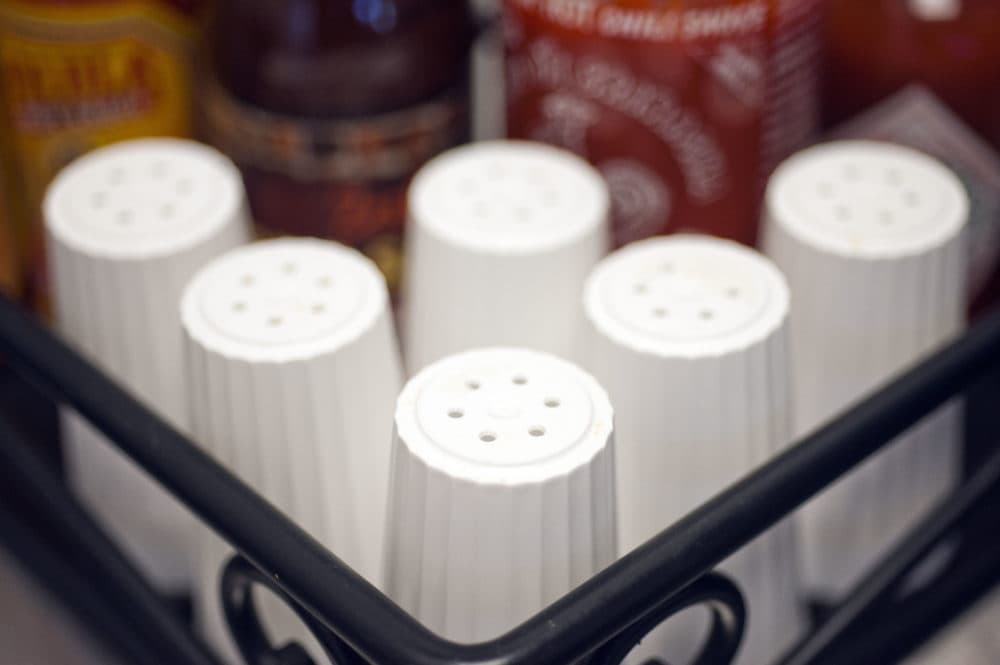Advertisement
One Easy Way To Improve Your Overall Health: Eat Less Salt
Resume
Most Americans eat far more salt than they should, exceeding the dietary guidelines for sodium.
Doctors say too much sodium leads to high blood pressure and increases the risk of heart disease and stroke. But how much salt is too much?
After almost a decade of controversy over this question, the National Academies of Science released new recommendations last year, says Dr. Dariush Mozaffarian, a cardiologist, professor of medicine at Tufts University and dean of the Tufts Friedman School of Nutrition Science and Policy.
According to the new guidelines, adults shouldn’t eat more than 2,300 milligrams of salt per day. But in reality, Americans are eating much more than that — close to 3,500 milligrams on average, Mozaffarian says.
“Globally, we're kind of right about average. There are some countries that are actually around [2,200 to 2,300] milligrams a day on average where they should be, mostly countries in Africa,” he says. “There's countries that are around 5,500, especially in Asia and China, where there's huge amounts of soy sauce.”
There aren’t any clear benefits to having a lot of salt in your diet, Mozaffarian says. Sodium actually causes more harm than good. For one, it raises blood pressure, which increases the risk of heart attack and stroke.
“Sodium gets into our bloodstream and it expands the volume, the amount of fluid in your bloodstream,” he explains, “and it makes the kidneys work harder to pump it out, and it makes the heart work harder to pump that extra fluid.”
Over the long term, high blood pressure can lead to scarring in blood vessels, the heart and kidneys, which can lead to problems such as heart or kidney failure, he says.
Mozaffarian says it’s pretty simple for individuals to gradually reduce salt intake because the human tongue receptors for salt are “very adaptable.”
“Within a few weeks, if you changed your salt intake and you increased it or decreased it dramatically, the tongue receptors adjust, so the food tastes the same again,” he says. “So that means if as a population, as a whole, we slowly reduce salt in this country over a few years, nobody would notice. All of our tongues would adapt and we'd be healthier.”
On an individual basis, reducing salt intake is easy. But in order to reduce salt levels on a mass scale, restaurants and the food industry need to get on board, Mozaffarian says.
In countries such as the United Kingdom and Turkey, governments have partnered with industry to establish voluntary sodium reduction targets, he says. But in the U.S., Congress has blocked similar efforts after pushback from parts of the food industry.
How foods are packaged and preserved needs to fundamentally change, Mozaffarian says.
Salt plays a key role in keeping foods fresh, he says. About 80% of salt in the U.S. food supply is from packaged and processed foods. In fact, a single slice of bread on average has more sodium than a serving of potato chips, he says.
“A serving of potato chips might have 80 or 100 milligrams of sodium on average. A single slice of bread, just one slice, can have 300 milligrams of sodium,” he says. “Bread shouldn't last for weeks in the grocery store and on your shelf without going bad, but it does. Much of that is the high sodium.”
It’s important to be more conscious of the amount of sodium in processed foods, especially now as more people are cooking at home during the coronavirus pandemic, Mozaffarian says.
“I think that nutrition is as important as ever,” he says. “I think, for those that are able to do it, [with] restaurants being closed, this is a great time to learn how to cook and get reacquainted with cooking. That's the simplest way to lower salt.”
Julia Corcoran produced and edited this interview for broadcast with Tinku Ray. Samantha Raphelson adapted it for the web.
This segment aired on May 15, 2020.

